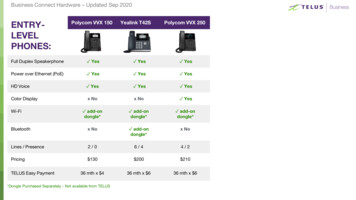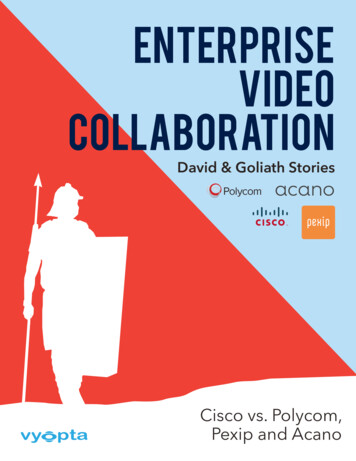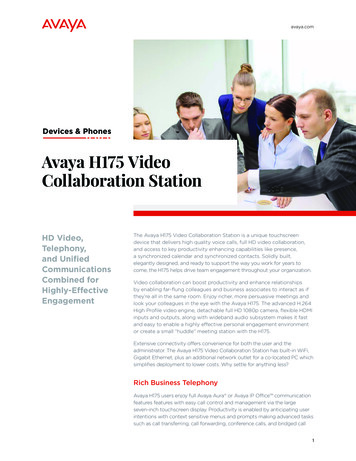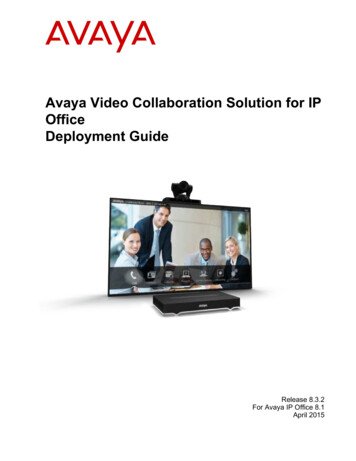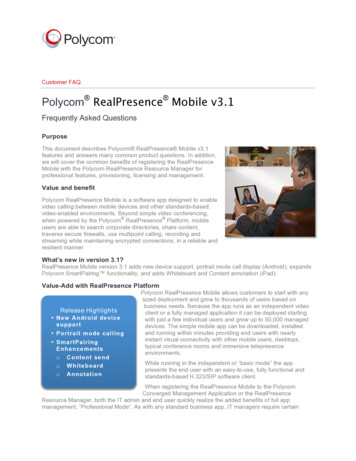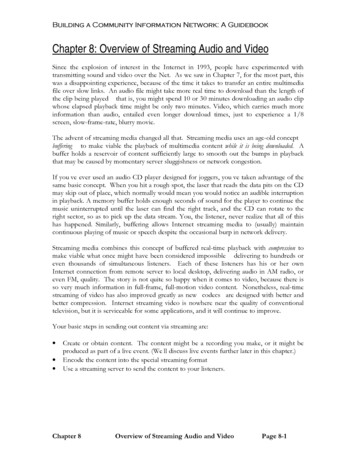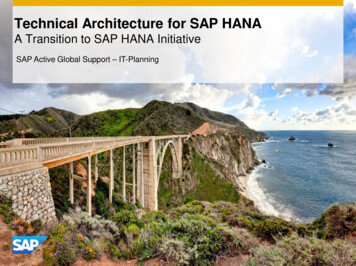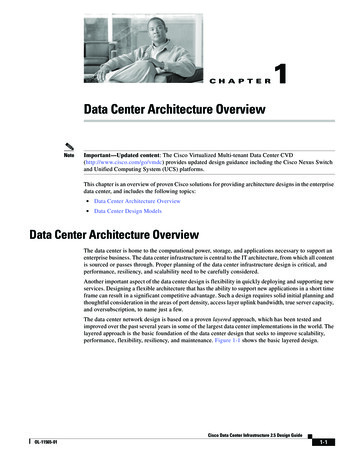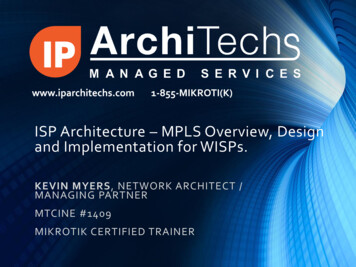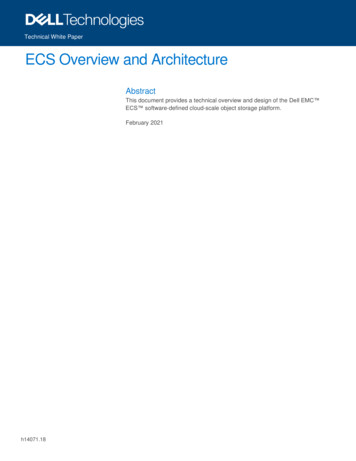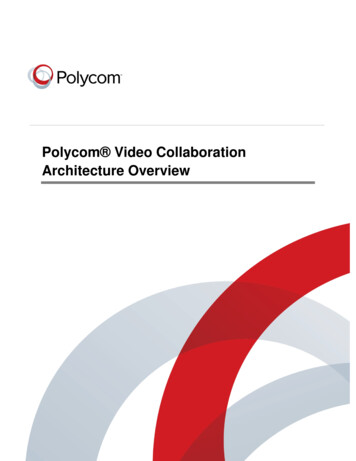
Transcription
Polycom Video CollaborationArchitecture Overview
IntroductionThis Polycom Video Collaboration Architecture Overview is a starting point for decision makersconsidering state of the art video conferencing solutions, and covers a wide variety of different conceptsrelated to video communications and important guidelines for video-enabled network design. Use thisOverview in conjunction with other documentation available from Polycom to create a comprehensiveplan for your enterprise video collaboration solution:There are a wide-range of video conferencing solutions available in the marketplace today. To help youunderstand available options, this Overview provides a breakdown of the terminology, technologycomponents, protocols, and deployment considerations needed to deploy a video collaboration solution.Polycom solutions are included when relevant, but additional vendor-neutral components are alsodiscussed to provide a non-biased view of video collaboration topics which all vendors face.Choosing the right solution for your needs can be difficult due to the large number of available optionsand technologies. Use this Overview to gain a solid, high-level understanding of the video conferencingrelated topics and background which you need to consider and how a video solution will integrate with therdfeatures, functionality and 3 party tools you have in place already.Polycom Assured DesignPolycom Assured Design (PAD) is a new program designed to take the guesswork out of providing a bestin class video solution; PAD provides a framework to guide your selection of products, versions andoptions that meet your video collaboration solutions needs.Polycom Video Endpoints and InfrastructureA quick guide to Polycom video endpoints and the Polycom RealPresence Platform gives backgroundinformation helpful to understand the different Polycom components that make up a state of the art videosolution.Key Video Collaboration Concepts and TermsAn introduction to the terminology and concepts used in video collaboration covers topics. Includesbackground information related to how captured video is packaged, compressed and delivered over thenetwork. International Telecommunications Union (ITU) Coding Standards for video are explained,including H.263/H.264 protocols and how they relate to video conferencing.Understand How Call Control and Media are Handled duringa Video ConferenceWhat happens under the covers during a video conference? When you walk into a conference room anddial the number provided in the calendar invite, how does the technology process this request? This
section covers the infrastructure you need to make sure the call is successful and provides details on thevarious protocols used for call control and processing media flows between video devices across thenetwork.Sharing Content during a Video ConferenceTrue collaboration in a video conference involves audio, video and high definition content sharing. Learnwhat you need to know to understand how content is shared during a conference.Transcoding, and Why You Need ItTranscoding is a key element in providing a video collaboration solution capable of handling differentendpoints with differing capabilities. Learn what transcoding is, where it takes place, and understand howdisparate endpoints can successfully communicate.Quality of Service (QoS) and Call Admission ControlReal-time video is sensitive to delay, loss and jitter. Video adoption within the enterprise is largely basedon the perception of quality experienced during a video conference, so managing QoS is a key factor tosuccessful video deployment. See how the Polycom RealPresence Platform provides QoS andmanages access to the network for different users and endpoint devices.SecurityThere are many considerations to address so that end-to-end security is provided for a video solution. Forexample, understanding how the RealPresence Platform integrates with Active Directory forAuthentication and providing Single SignOn (SSO). See how to address other important securityconsiderations, include encrypting the signaling and media traffic during all phases of call control andmedia relay.Deployment ScenariosDeployment scenarios are based on a variety of factors -- the number and type of endpoints, networkdesign, call control and more—and there is no one solution for a deployment scenario. There are differentconsiderations to take into account as you roll out a video solution and you’ll need to consider thefollowing: that people can use their own devices or UC client, that your video solution is easy to use, thatyour solution integrates tightly with existing IT infrastructure including LDAP, email/calendar, and SNMPmonitors.Important Considerations for Video DesignSolutionsThere are many different considerations to take into account before rolling out a video collaborationsolution. The most important piece is to ensure that people can easily adopt and use the solution as partof their daily workflow. Often, this means the solution tightly integrates with existing IT infrastructure like
LDAP, Email, Calendar, SNMP and existing video equipment. Other considerations include the numberand type of endpoints in place, network design, dial plan, mobility, security and more.At Polycom, we recognize the importance of Unified Communications and Collaboration (UC&C) to thesuccess of your business. We also recognize that distributed architectures, scale, redundancy, differentprotocols, multiple UC vendors, and a plethora of feature-rich user options can lead to complex videodeployments.The Polycom Assured Design ProgramPolycom Assured Design, or PAD, is a program designed to take the guesswork out of designing,building, using and supporting your UC&C experience. Polycom has assembled a team of customersavvy experts, infrastructure and endpoint engineers and support teams to quantify the most commonarchitectures and use models for our customers.The Polycom team begins its assessment by understanding the customer's business, their physicallocations and existing UC&C workflow to establish a bell curve of common use architectures and currentusers’ workflows.Next, the Polycom team builds customer defined UC&C architectures using the customer’s workflows tocreate test criteria for both installation and end-user experience. And, the Polycom team spends timeworking with Polycom engineering teams to test and retest Polycom components and solutions exactlythe way they will be deployed and used in a PAD architecture.When all of the architectures are documented, all the test cases are documented, and all workflows aredocumented, the PAD team provides this information to Polycom partners and customers.PAD teams provide the foundation for customer solution design, based on common use cases andcurrent engineering system priorities. The teams incorporate a broad set of technologies, features andapplications to address customer needs. Each crafted solution will be comprehensively tested anddocumented by Polycom engineers to ensure more reliable and predictable deployment and support, aswell as greater certainty of a positive customer experience.When the a customer implements a PAD architecture, they can do so with confidence and demonstratedevidence that their solution has been thoroughly tested and vetted by a global team of Polycom experts.To learn more, go to www.polycom.com/pad.Polycom Video Endpoints and InfrastructurePolycom has a full range of infrastructure and endpoints available to handle video collaboration needsfrom the desktop to the boardroom.Polycom RealPresence PlatformPolycom is the global leader in standards-based unified communications (UC) solutions for telepresence,video, and voice, powered by the Polycom RealPresence Platform. The RealPresence Platforminteroperates with the broadest range of business, mobile, and social applications and devices. ThePlatform was designed with a singular vision – to defy distance and unleash the power of humancollaboration.
The story behind Defy DistanceWe live in a world filled with distance. Not just the miles that stretch between Meeting Room A andConference Room B. But also the misunderstanding that lingers between hypothesis and proof. The timethat passes between diagnosis and cure. And the revisions that multiply between major bug and “easyfix.”In every type of industry, in every type of company, distance—in all its many manifestations—is theenemy. If a business is to move forward, this is the foe to be conquered.At Polycom, eliminating the distance between problem and solution is our unified mission. Our singledriving purpose. The very reason we exist.Everything we do, from our high-definition conference phones to our state-of-the-art collaborationsolutions, is designed to empower our customers to accomplish the one feat that changes everything:DEFY DISTANCE.Deploy RealPresence Platforms via Hardware Appliance or SoftwareWith the rise of the virtualized datacenter, Polycom has evolved the components of the RealPresencePlatform to support virtual software deployment strategies increasing the flexibility, manageability, andefficiency of your video deployment. The RealPresence Platform can now be deployed as software,making video and voice collaboration simple and scalable in any environment.For customers who have already invested in hardware components of the Polycom RealPresencePlatform, the virtual editions offer an easy transition to software by working seamlessly with existinghardware infrastructure. This architecture eliminates collaboration silos caused by systems that don’t talkto each other, including support for emerging standards such as SVC. Virtual editions of the platform arestandards-based and natively interoperable with UC solutions that already exist in a customer network,and also with third-party vendor solutions, giving customers the best investment protection in the industry.Endpoint Connection processThe diagram below presents a visual depiction of the RealPresence Platform as deployed in a customerenvironment. Starting from the left side of the diagram, the endpoints coming in from outside the firewallconnect through the RealPresence Access Director or SBC. All internal and external endpoints areprovisioned through the RealPresence Resource Manager allowing administrators to remotely manage,configure and update clients.The RealPresence Distributed Media Application (DMA) handles all endpoint SIP and H.323 registrationsalong with any incoming call requests. The call requests are distributed amongst the group of MCUs inthe resource pool. Video streaming and recording requests are also handled by the DMA which accessesthe pool of available RealPresence Capture Server resources.Each of the real presence platform components are provisioned using platform director as a sort oforchestration server to administering the environment. Platform director can be used from everything toinstallation licensing configuration and monitoring.
Diagram of Polycom Video ArchitectureComponents of Polycom Video ArchitectureModuleComponentDescriptionCall ControlRealPresence DMA Provides endpoint registration, call processing, and mediaresource managementConferencingRealPresence Collaboration ServerProvides audio and video conferencing resourcesCollaboration EdgeRealPresence AccessDirector Enables firewall traversalRealPresence CloudAXIS SuiteManagementApplicationsRealPresence Platform Director Enables B2B/B2C collaboration via browser or standard basedendpointsSingle glass management applicationManages client and server applicationRealPresence Resource ManagerRecordingRealPresence Capture ServerProvides Recording, Playback and Streaming capabilitiesEndpointsRealPresence GroupSeriesPolycom endpointsPolycom HDX SeriesPolycom RealPresence Desktop
Polycom RealPresence MobileImmersivePolycom RealPresence Distributed Media Application (DMA )Polycom RealPresence Distributed Media Application is a mission critical application for unifyingconferencing and collaboration networks, ensuring business continuity and maximizing UC investmentsand includes call control for SIP and H.323 devices (AVC and/or SVC). The highly resilient and scalablePolycom RealPresence DMA solution supports any size video network from small deployments of lessthan 100 devices to an unmatched scale of 25,000 concurrent calls and 75,000 registrations for thelargest available networks.The RealPresence DMA solution is engineered to provide intelligent load-balancing and redundant autofailover, configured in geographically distributed super clusters, deliver unmatched resiliency. Utilizingintelligent algorithms, the powerful software inside the RealPresence DMA solution dynamically routescalls throughout the network based on priority, class of service, resource availability, network outage, andhighly efficient load balancing and virtualization of bridging resources. Centralized reporting andmonitoring and native integration with Microsoft Active Directory dramatically simplifies “meeting room”provisioning and slashes ongoing administration costs.Benefits: Premier Scale—H.323 Gatekeeper/SIP Registrar for up to 75,000 devices & 64 bridges Exceptional Connectivity—SIP/H.323 Gateway (ex: connect UC/Voice users with HDX users) Unmatched Resiliency—Super cluster (up to 5 DMA nodes) and geographic redundancy Guaranteed class of service and experience (silver/gold/platinum) API Suite—Increase end user productivity and lower administration cost via API for conferencemonitoring, provisioning users and VMRs, resource reporting and billing Provide resource management, load balancing, scale and resiliency for up to 64 CollaborationServers, Codian 4x00, MSE 8000 MCUs Native UC integration with Microsoft, IBM, Unify and JuniperThe diagram below depicts how the DMA Solution load balances between the different MCUsavailable, based on the incoming number of call requests and available resources on the backend.
Polycom RealPresence Collaboration Servers (RMX)The Polycom RealPresence Collaboration Server (RMX) Conference Platform makes use of a multipointcontrol unit, or MCU, application to provide universal bridging capabilities for seamless connectivityregardless of bandwidth, device, or protocol. Polycom’s Real Presence Collaboration Server (RMX)allows organizations to unite teams over distance in any media from users in immersive Telepresencesuites to remote audio callers. Across all bandwidths, devices and protocols, the RealPresenceCollaboration Server RMX 4000 delivers high quality group communication for increased knowledgesharing and faster team decision making at large organizations.For managing wide-scale conference deployments, the Polycom Distributed Media Application (DMA )pairs with the RealPresence Collaboration Server RMX 4000/2000/1500 to deliver unmatchedredundancy, scale, flexibility, and control for conferencing.When the RealPresence Collaboration Server is in place, high quality interactions are achieved via lifelike video (up to 1080p), audio, and shared content. Conferences may be scheduled and closelymanaged with operator assistance or run entirely on demand. Virtual meeting rooms may be easilyadjusted to fit unique personal or organizational requirements, and also provide on demand access forend users to bridge resources. Meeting participants may modify conference views while in session,maximizing their unique experience.Benefits: Enabling network scale – Up to 360 resources per Chassis and support of up to 64 MCU’s with thePolycom DMA 7000 Redundancy - Redundant power supplies, AC or DC power options & LAN Redundancy Audio Conferencing - The RMX can be used as an audio bridge which can support up 400 PSTN or800 VoIP audio ports Multi-network - Supports IP, SIP, SVC, PSTN Voice and ISDN Video in the same chassis and onthe same conference Multi-protocols – H.264 High Profile, Microsoft Real Time Video (RTV), Telepresence InteropProtocol (TIP) Gateway - No need for an additional Gateway device, use the RMX Meet me MCU or Dial throughGW capabilities
Telepresence – Supports the Polycom Telepresence solutions with Customizable TelepresenceCP Layouts SVC Option – Scalable Video Codec is an option – Also supports AVC/SVC in mixed conferences Call at any data rate, any bandwidth with support for resolutions up to 1080p 60, fully transcoded Native integration with Microsoft Lync, IBM Sametime , Siemens OpenScape, Avaya Aura solutionsThe diagram below demonstrates the wide array of video endpoints and protocols that aresupported on the RealPresence Collaboration Server.Polycom RealPresence Resource ManagerPolycom’s RealPresence Resource Manager provides video resource management for enterprise andservice provider networks. The Polycom RealPresence Resource Manager Software applicationmonitors, manages and provisions thousands of video devices and provides directory, scheduling andreporting services. From this single, powerful management solution, organizations can manage videodevices across a global network, including video-enabled tablets and smart phones, desktop systems,conference room systems, and immersive telepresence theatres. Any organization benefits from bothimproved costs savings from resource optimization and operational efficiencies with API basedprovisioning and multi-tenant functions. End user experience is enhanced, providing easy dialing withpresence and familiar directories, and low maintenance with remote configuration and automatic softwareupdates.For large scale networks, RealPresence Resource Manager along with the Polycom RealPresence DMA provides a scalable and highly reliable video management solution. Both are built on Linuxoperating system and incorporate database synchronization methods to reduce possible outage time.
RealPresence DMA provides super clustering for scale and resiliency for video call control and bridgevirtualization while RealPresence Resource Manager focuses on the device monitoring, management,directories, and scheduling functions.A key component of the Polycom RealPresence Platform, the RealPresence Resource Manager softwareis critical to effectively managing thousands of mobile, desktop, and group telepresence systems.Administrators can use it to centrally provision, monitor and manage the entire video collaborationnetwork. Through dynamic provisioning, it automatically configures and maintains thousands of videoclients at pre-determined software baselines. This eliminates having a variety of software releases in thefield, fixing end-user configuration mismatches, being uncertain about the quality of video being provided,and other typical management issues.Built-in reports, application dashboards, and drill-down tabs ensure you can instantly accesstroubleshooting and operational metrics are readily available.Polycom RealPresence Access Director SoftwarePolycom RealPresence Firewall Traversal and Security solutions remove communication barriers toallow your teams to collaborate more effectively over video. These solutions provide a secure route forusers to connect from virtually any location and device, providing support for business-to-business andintra-company collaboration. A software based edge server—RealPresence Access Director—securelyroutes communications, management and content through firewalls without requiring additional clienthardware or software.RealPresence Access Director provides: SIP/H.323 Combined Support: Single server application that combines the guest user and B2B callingscenarios with SIP and H.323 capabilities enabling a seamless video collaboration experience withinand beyond the firewall Secure Collaboration from Anywhere: Collaborate over video while on-the-go, in the office or fromhome Reduce the Cost to Scale: Support up to a thousand simultaneous video calls securely withoutrequiring additional client hardware or software Investment Protection – Now and for the Future: Leverage ex
Polycom Video Collaboration Architecture Overview is a starting point for decision makers considering state of the art video conferencing solutions, and covers a wide variety of different concepts related to video communications and important guidelines for vide
